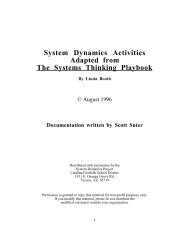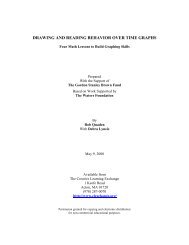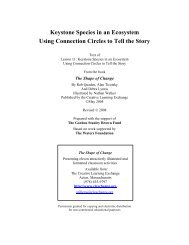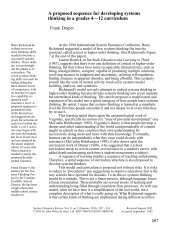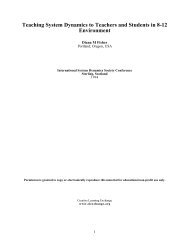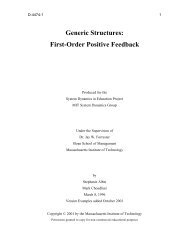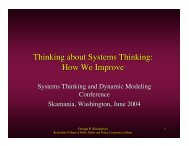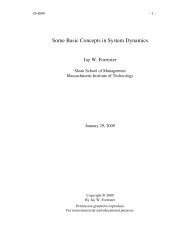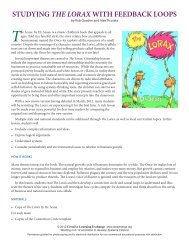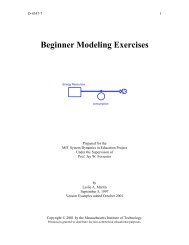System Dynamics in K-12 Education: Lessons Learned - Creative ...
System Dynamics in K-12 Education: Lessons Learned - Creative ...
System Dynamics in K-12 Education: Lessons Learned - Creative ...
Create successful ePaper yourself
Turn your PDF publications into a flip-book with our unique Google optimized e-Paper software.
CIESD: Go<strong>in</strong>g Forward<br />
Rema<strong>in</strong><strong>in</strong>g engaged with the K-<strong>12</strong> community is one of CIESD’s greatest desires, but two<br />
primary barriers restrict the time we can devote to that and the benefit that that time can realize.<br />
First, there seems to be little reward for educators to seek out and develop <strong>in</strong>novative and<br />
effective ways to accomplish high-level, collaborative, self-directed, problem-solv<strong>in</strong>g,<br />
<strong>in</strong>terdiscipl<strong>in</strong>ary learn<strong>in</strong>g on the part of their students whether or not that directly <strong>in</strong>volves SD.<br />
“What is measured is what is valued,” and, despite language <strong>in</strong> state standards and frameworks<br />
that advocates for such learn<strong>in</strong>g, the standardized tests that constitute the true public measure of<br />
educational success do not typically address those higher-level learn<strong>in</strong>g objectives. We need to<br />
f<strong>in</strong>d tools and directions to allow us to br<strong>in</strong>g the benefits of SD <strong>in</strong> ‘under the radar’ and have it<br />
visibly contribute to, or at least not distract from, those test-based aspirations. Re<strong>in</strong>forced by that<br />
focus on test results is an unwill<strong>in</strong>gness to commit the time and <strong>in</strong>vest the f<strong>in</strong>ancial resources<br />
needed for SD-competent educators to create the curricular materials and tra<strong>in</strong><strong>in</strong>g opportunities<br />
needed for growth <strong>in</strong> these SD applications. Without that focused and effective outreach to new<br />
educators, the current crop of SD <strong>in</strong>novators have little opportunity to br<strong>in</strong>g new participants <strong>in</strong>to<br />
the fold, create effective applications, or create of such powerful educational opportunities, That<br />
suggestion of a re<strong>in</strong>forc<strong>in</strong>g loop makes a depress<strong>in</strong>g story when it operates <strong>in</strong> its ‘death spiral’<br />
mode. On the other hand, if it can once be turned around, such a re<strong>in</strong>forc<strong>in</strong>g loop creates<br />
powerful growth dynamics. What’s the policy that will allow that fundamental and crucial<br />
change of direction?<br />
Conclusions: What Have We <strong>Learned</strong>?<br />
Without a doubt, all of the <strong>in</strong>novative pioneers represented here would agree that <strong>in</strong>fus<strong>in</strong>g system<br />
dynamics <strong>in</strong>to K-<strong>12</strong> education has been an enrich<strong>in</strong>g experience for them and, especially, for<br />
their students. Teachers are always impressed by the depth of understand<strong>in</strong>g that students can<br />
achieve when they are engaged <strong>in</strong> view<strong>in</strong>g problems through a system dynamics perspective.<br />
Anecdotal evidence shows us that system dynamics can “offer a framework for giv<strong>in</strong>g cohesion,<br />
mean<strong>in</strong>g, and motivation to education at all levels from k<strong>in</strong>dergarten upward” (Forrester, 1992,<br />
1), as Forrester foresaw fifteen years ago.<br />
However, although we have all been encouraged and <strong>in</strong>spired by student performance us<strong>in</strong>g<br />
system dynamics/systems th<strong>in</strong>k<strong>in</strong>g <strong>in</strong> some classrooms and by the benefits of learn<strong>in</strong>g<br />
organization pr<strong>in</strong>ciples <strong>in</strong> some schools, we have not yet seen widespread adoption of system<br />
dynamics <strong>in</strong> the curriculum or culture of schools. In fact, there may be less system dynamics <strong>in</strong><br />
these schools now than there was when the Essex meet<strong>in</strong>g convened <strong>in</strong> 2001. Unfortunately,<br />
most of the programs described (and several others not represented here) have not been able to<br />
ma<strong>in</strong>ta<strong>in</strong> <strong>in</strong>itial momentum after major outside fund<strong>in</strong>g ended. Why is that? What can we learn<br />
from our experience so that we can cont<strong>in</strong>ue to fulfill the promise of system dynamics <strong>in</strong><br />
education and provide students with the skills and perspective they will need?<br />
Certa<strong>in</strong>ly the obstacles to implement<strong>in</strong>g change have been more formidable than any of us<br />
expected. K-<strong>12</strong> education is a large <strong>in</strong>stitution with built-<strong>in</strong> resistance to change. Because<br />
teachers are most comfortable teach<strong>in</strong>g what they themselves were taught, usually <strong>in</strong> a teacher-<br />
<strong>Creative</strong> Learn<strong>in</strong>g Exchange<br />
www.clexchange.org<br />
24



